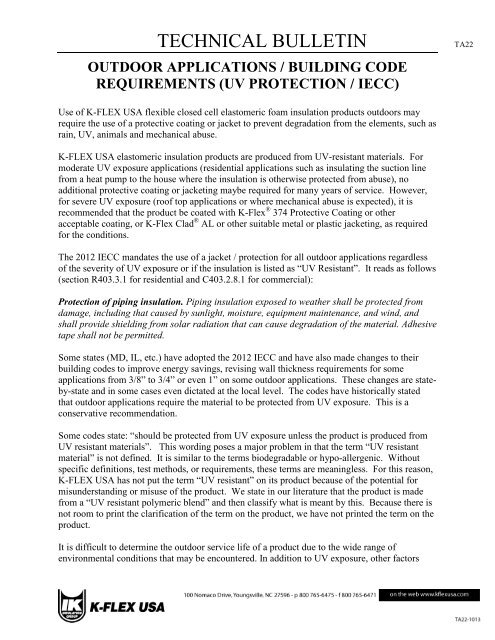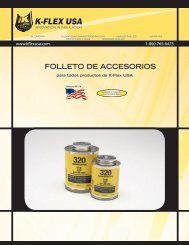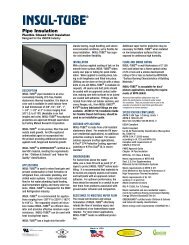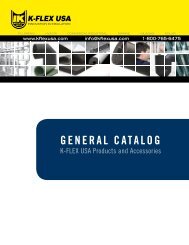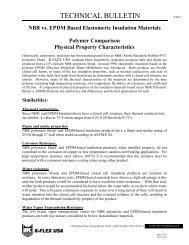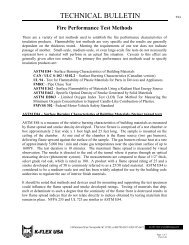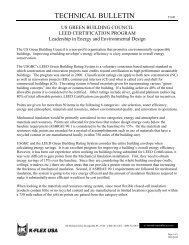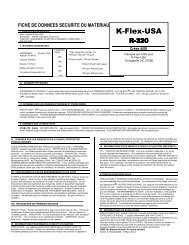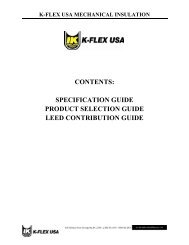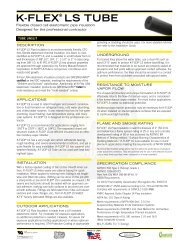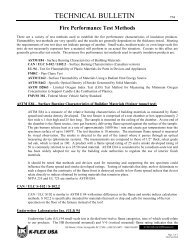TA22 Outdoor Applications - K-Flex USA
TA22 Outdoor Applications - K-Flex USA
TA22 Outdoor Applications - K-Flex USA
Create successful ePaper yourself
Turn your PDF publications into a flip-book with our unique Google optimized e-Paper software.
TECHNICAL BULLETIN <strong>TA22</strong>OUTDOOR APPLICATIONS / BUILDING CODEREQUIREMENTS (UV PROTECTION / IECC)Use of K-FLEX <strong>USA</strong> flexible closed cell elastomeric foam insulation products outdoors mayrequire the use of a protective coating or jacket to prevent degradation from the elements, such asrain, UV, animals and mechanical abuse.K-FLEX <strong>USA</strong> elastomeric insulation products are produced from UV-resistant materials. Formoderate UV exposure applications (residential applications such as insulating the suction linefrom a heat pump to the house where the insulation is otherwise protected from abuse), noadditional protective coating or jacketing maybe required for many years of service. However,for severe UV exposure (roof top applications or where mechanical abuse is expected), it isrecommended that the product be coated with K-<strong>Flex</strong> ® 374 Protective Coating or otheracceptable coating, or K-<strong>Flex</strong> Clad ® AL or other suitable metal or plastic jacketing, as requiredfor the conditions.The 2012 IECC mandates the use of a jacket / protection for all outdoor applications regardlessof the severity of UV exposure or if the insulation is listed as “UV Resistant”. It reads as follows(section R403.3.1 for residential and C403.2.8.1 for commercial):Protection of piping insulation. Piping insulation exposed to weather shall be protected fromdamage, including that caused by sunlight, moisture, equipment maintenance, and wind, andshall provide shielding from solar radiation that can cause degradation of the material. Adhesivetape shall not be permitted.Some states (MD, IL, etc.) have adopted the 2012 IECC and have also made changes to theirbuilding codes to improve energy savings, revising wall thickness requirements for someapplications from 3/8” to 3/4” or even 1” on some outdoor applications. These changes are stateby-stateand in some cases even dictated at the local level. The codes have historically statedthat outdoor applications require the material to be protected from UV exposure. This is aconservative recommendation.Some codes state: “should be protected from UV exposure unless the product is produced fromUV resistant materials”. This wording poses a major problem in that the term “UV resistantmaterial” is not defined. It is similar to the terms biodegradable or hypo-allergenic. Withoutspecific definitions, test methods, or requirements, these terms are meaningless. For this reason,K-FLEX <strong>USA</strong> has not put the term “UV resistant” on its product because of the potential formisunderstanding or misuse of the product. We state in our literature that the product is madefrom a “UV resistant polymeric blend” and then classify what is meant by this. Because there isnot room to print the clarification of the term on the product, we have not printed the term on theproduct.It is difficult to determine the outdoor service life of a product due to the wide range ofenvironmental conditions that may be encountered. In addition to UV exposure, other factors
TECHNICAL BULLETIN <strong>TA22</strong>such as damage from maintenance workers, wildlife and weather conditions must also beconsidered. Protective coatings / jacketing can provide physical, as well as UV protection.Accelerated UV aging studies are difficult to correlate to actual outdoor exposure because of thewide range of potential exposures in different parts of the country. There are no industryaccepted performance criteria to determine acceptable performance. As such, K-FLEX <strong>USA</strong>cannot provide any general life expectancy for our products when used outdoors. Ourrecommendations are based on more than 30 years of experience in the elastomeric insulationindustry.In some applications (as noted above) the product will perform to industry expectation, but insevere UV exposure applications or where other factors may enter into the conditions the productwill be exposed to, it may not perform to the expectation of the owner without additionalprotection. Because of the confusion caused by this wording (UV resistant materials) somestates such as California, who had used this wording, have now removed it from their code.They have gone back to a statement that requires all products used outdoors have additional UVprotection such as coating or jacketing.K-FLEX <strong>USA</strong> feels it is better to provide a conservative recommendation along with informationon which our customers can make an informed decision.


